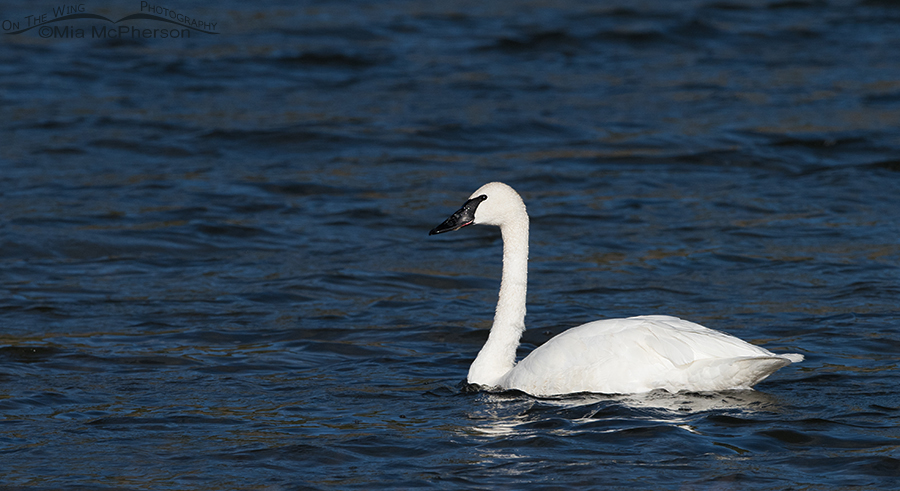In the 1930’s Trumpeter Swans were thought to be extinct due to over-harvesting for food, the use of their skins for ladies powder puffs and their feathers that were used in millinery. These huge birds with eight foot wing spans nearly went the way of the Passenger Pigeon, Carolina Parakeet and the Dodo.
 Trumpeter Swan on Elk Lake – Nikon D810, f8, 1/3200, ISO 400, -0.7 EV, Nikkor 500mm, natural light
Trumpeter Swan on Elk Lake – Nikon D810, f8, 1/3200, ISO 400, -0.7 EV, Nikkor 500mm, natural light
Small populations of Trumpeter Swans were found in mountain valleys in Montana, Idaho and Wyoming and those birds are the reason we have Trumpeter Swans today.
In 1935 Red Rock Lakes National Wildlife Refuge in the Centennial Valley of southwestern Montana was established to help save and restore Trumpeter Swans and it has been a success. By the 1960’s Trumpeter Swans were relocated to Minnesota and other areas of the Midwest to help increase their chances for survival. It took a long time for Trumpeter Swan populations to rebound and today they are still increasing and the swans are expanding back into their historical ranges.
There are still threats that can harm stable populations of the largest waterfowl in North America. They can be mistaken for Tundra Swans during hunting season, they can suffer poisoning from lead shot and deaths due to power line collisions.
I recall the first time I saw Trumpeter Swans at Red Rock Lakes as a pair of them flew past me as I stood on the shore of the Lower Lake and listened to their resonating calls. I felt honored to be able to see these amazing swans that at one point were so very close to extinction.
If not for the government, scientists, biologists, concerned citizens and refuge managers we might not have them gracing our skies, marshes and lakes now.
I can’t imagine the earth without them. I can’t imagine the Centennial Valley without their calls or their beauty and grace.
Mia
Click here to see more of my Trumpeter Swan photos plus facts and information about this species.
By the way, I don’t think we thank our National Wildlife Refuge Managers enough for the roles they play in the restoration of native species or for the sacrifices they make in living in remote areas like Red Rock Lakes National Wildlife Refuge in Montana and Fish Springs National Wildlife Refuge in western Utah. Bill West is currently the manager at Red Rock Lakes NWR and my friend Jay Banta was the manager at Fish Springs NWR for years before he retired.
Thanks to Bill West for his continuing efforts at Red Rock Lakes NWR. (Could you please get some water into the ponds by the dam at the Lower Lake? The shorebirds need it.)
Thanks Jay for all that you did for Fish Springs NWR. I know it is a better place because of you.
For more information visit The Trumpeter Swan Society.


Thank you. And those who work so tirelessly to keep other species safe.
Hi Mia,
I live across the water from Vancouver Island’s Comox Valley. You can read all about Vancouver Island’s winter Trumpeter population here http://www.geog.uvic.ca/viwilds/iw-swan.html
Thanks for bringing their rescue from extinction to everyone’s attention. I, too, can’t imagine a world without such beautiful creatures.
I think we can also thank a 1903 executive order issued by President Theodore Roosevelt for establishing the first unit of the present National Wildlife Refuge System.
I agree. The Ken Burns series on PBS last week was a good remineder of what a benefit government can be; special thanks to Teddy, FDR, and Eleanor Roosevelt for their hard work to greatly improve this country.
BTW, I was thinking of taking down my lonely hummingbird feeder today, but in the light rain a female Black-Chinned took several long drinks. Exciting! And I love the image and story of the swan too.
Mia,
Thank you for publicly thanking the hard working folks and visionaries that make restoration happen. Extinction is for ever!
The Trumpeter Swan has been restored in Ontario too, thanks to the dreams and hard work of a handful of folks with vision, commitment, and amazing energy. TheyARE spectacular birds!
Glen
A beauty against that dark blue water!
Wonderful birds! Need to do anything to save them!
I’ve been underneath a mute when he flew by, awesome experience, but don’t think I’ve ever seen a trumpeter. They are sooooo glorious … great image, Mia!!!
Hi! Yes thank you for fighting for our earth and all living things on this planet! I am so very proud of you!!!
Thanks for being an advocate for these beautiful, stately big birds…this gorgeous images says it all…love the contrast between the inky wayers and the snowy white bitd…. Thank you, too, for being an advocate and appreciator of those who work so hard on their behalf…